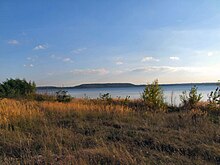

The Geiseltal fossil deposit is located in the former lignite district of the Geiseltal south of the city of Halle in Saxony-Anhalt, Germany. It is an important site of now extinct plants and animals from the Middle Eocene period 48 to 41 million years ago. There is evidence that coal was first mined in the Geiseltal in 1698, but the first fossils only came to light by chance at the beginning of the 20th century. Scheduled scientific excavations began in 1925 by the Martin Luther University Halle-Wittenberg. Interrupted by World War II, the investigations can be divided into two research phases. Due to the increasing depletion of the raw material deposits, the excavations gradually came to a standstill in the mid-1980s and finally ended at the beginning of the third millennium.
The lignite of the Geiseltal is subdivided into four main seams, the three lower ones were mainly fossil-bearing. The focus of the fossil distribution is in the southern and central Geiseltal. The finds include remains of plants and animals. A special feature are almost complete finds with leaves, fruits and stems, but also skeletons of vertebrates and remains of insects. One of the most famous finds is that of a complete skeleton of the prehistoric horse Propalaeotherium from 1933. Other vertebrates include even-toed ungulates, small mammals such as insectivores and bats as well as birds, crocodiles, turtles, snakes, amphibians and fish. Remains of soft tissue were also found in numerous vertebrates. In total, more than 80 individual sites with more than 50,000 finds are known, including 36 with a significant number of vertebrates. Due to the good and extensive preservation of fossils, the Geiseltal is considered a conserve and concentrate deposit.
The special feature of the Geiseltal fossils, above all the vertebrates and especially the mammals, lies in their unique preservation in lignite, which is not found anywhere else in Central Europe. The Geiseltal is an important site for the development of mammals, as the development of individual groups can be observed there over a period of several million years. This makes the mammal fauna a reference for the Geiseltalium, a section of the stratigraphy of European land mammals from 47 to 43 million years ago. The extensive finds from the animal and plant world, as well as the numerous geological data, make it possible to reconstruct the landscape quite accurately. According to this, at the time of lignite formation there was a multi-storey lowland forest near the coast, which was interspersed with streams, ponds and bogs. The forest was subject to the influence of subtropical climate and was home to a species-rich fauna. The entire fossil record of the Geiseltal is under national protection.